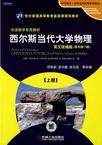西尔斯当代大学物理 上册 英文改编版
出版时间:2009-9 出版社:机械工业出版社 作者:(美)扬,(美)弗里德曼 著,邓铁如 等改编 页数:434
Tag标签:无
前言
1.关于原书、原作者本书改编自培生教育出版公司(Pearson Education,Inc.)于2004年推出的西尔斯大学物理第11版(Sears and Zemansky’s UNIVERSITY PHYSITCS with modern physics,11th edition,以下简称西书)。西书是美国几代物理教育专家长达半个多世纪探索与改革的产物。初版由美国物理教育界领军人物F.W.Sears和M.W.Zemansky于1949年推出。西书作者提倡站在学生的角度探究式地展开讨论,强调讲透概念、原理与培养学生解题能力并重,在版面设计上作出有针对性的安排。这些探索成果对促进学生自主学习产生了较大反响。西书第11版的主要作者H.D.Young自1973年始成为Sears和Zemansky的合作者,参加第5版编写。前两位作者相继去世后,Young从第8版起单独署名。他继承与完善了西书的导学式理念,使西书不仅在美国,而且在其他国家影响了一代又一代的大学师生,至今仍是发行量最大的主流教材之一。另两位作者R.A.Freedman与A.L Ford分别自第10版、第11版参加编写工作。西书曾于20世纪50年代以《西尔斯物理学》之名被翻译成中文在中国出版。当时该书受到我国大学物理教师的关注并作为教学参考书。至今我国物理教材中的一些讲法和习题都渊源于该书。机械工业出版社2003年影印出版了西书第10版。由于特色鲜明、角度新颖、讲解详尽、讨论深入,加之行文流畅,代表了当前英语科技文献流行风格,该影印版被一些高校选作物理双语课本,获得好评。西书第11版的刚体力学、振动与波、热学、电磁学、波动光学、狭义相对论与量子物理基础等6部分(覆盖大学物理课程教学内容9成以上)涵盖的知识点、调用的数学知识以及达到的难度与深度,同国内流行教材吻合度很高,适合选作非物理类尤其是工科专业的大学物理双语教材。
内容概要
本英文改编教材的原书——《西尔斯物理学》是几代编著者长达半个多世纪物理教育探索与创新的产物,其许多可圈可点的特色在美国乃至世界其他国家,影响了一代又一代的大学师生,是当今世界发行量最大的主流教材之一。 本教材分上下两册。本书是下册,主要内容有电磁学、波动光学、近代物理学等。 本书既充分体现了原书的特色,又在适合我国国情方面有了新的特点,主要表现在:对原书取舍得当,篇幅适当,教材内容覆盖了教育部最新教学基本要求建议的75个A类知识点和部分B类知识点;教材95%以上是原书的文字,体现了原书教学理念的精华,整个教材体系具有更好的系统性和完整性;内容生动、丰富,图文并茂,举例鲜活,趣味性强,联系实际密切,强调概念理解,注重能力培养;每章的问题引入法、正文探索式的叙述法以及每节的思考题检测法等多种教学方法并用,将有效调动学生学习的积极性,提高学生学习的效能;所有例题都采用四步解题法:审题(Identify)、破题(Set up)、求解(Excute)和讨论(EvaIuate),这种规范、科学的解题方式十分有利于学生形成思维清晰、表述准确、方法明确的解题习惯,并能逐步获得较强的解决实际问题的能力;英语行文规范、流畅,原汁原味,代表了当前科技英语文献的风格,是我国学生学习英文科技写作的极好范本。 本教材为高等学校理工科各专业学生的大学物理双语教学专用教材。由于与国内教材有很强的相关对应性,故对于希望了解物理知识英文表述的非双语教学的师生及其他科技工作者,本书也是一本十分有益的参考书。
作者简介
作者:(美国)扬(HUGH D.YOUNG) (美国)弗里德曼(ROGER A.FREEDMAN) 改编:邓铁如 徐元英 孟大敏 等
书籍目录
Preface1 PHYSICAL QUANTITIES AND VECTORS 1.1 The Nature of Physics 1.2 Idealized Models 1.3 Standards and Units 1.4 Uncertainty and Significant Figures 1.5 Vectors and Scalars 1.6 Vector Algebra 1.7 Unit Vectors and Component Expression Answer to Chapter Opening Question Exercises2 KINEMATICS 2.1 Particle Kinematics 2.2 Position Vector and Displacement 2.3 Velocity and Acceleration 2.4 Rectilinear Motion 2.5 Two Fundamental Problems in Kinematics 2.6 Relative Motion Answer to Chapter Opening Question Exercises3 DYNAMICS 3.1 Particle Dynamics 3.2 Newton' s Laws 3.3 Understanding Forces 3.4 Dynamics of Circular Motion 3.5 Non-inertial Frame and Inertial Forces Answer to Chapter Opening Question Exercises4 WORK AND ENERGY 4.1 Kinetic Energy and Work 4.2 Calculating the Work 4.3 Path Independence of Conservative Forces 4.4 Potential Energy 4.5 Conservation of Mechanical Energy 4.6 Find the Conservative Force from Potential Energy Answer to Chapter Opening Question Exercises5 MOMENTUM AND IMPULSE 5.1 Definition of Momentum 5.2 Conservation of Momentum 5.3 Impulse 5.4 Collisions 5.5 Center of Mass 5.6 Rocket Propulsion 5.7 Problem-Solving Strategy ISEE Answer to Chapter Opening Question Exercises6 ROTATION OF RIGID BODIES 6.1 Angular Velocity and Acceleration 6.2 Rotation with Constant Angular Acceleration 6.3 Relating Linear and Angular Kinematics 6.4 Energy in Rotational Motion ……7 DYNAMICS OF PROTATIONAL MOTION8 PERIODIC MOTION9 MECHANICAL WAVES10 TEMPERATURE AND HEAT11 THERMAL PROPERTIES OF MATTER12 THE FIRST LAW OF THERMODYNMAICS13 THE SECOND LAW OF THERMODYNAMICS14 ELECTRIC CHARGE AND ELECTRIC FIELD15 GAUSS'S LAW16 ELECTRIC POTENTIAL17 CAPACITANCE AND DIELECTRICS18 CURRENT, RESISTANCE AND ELECTROMOTIVE PORCEAPPENDICES教学支持信息表(填写本表,获取本书教辅资源)
章节摘录
插图:As we learned in Section 1.1, physics is an experimental science. Experiments require meas-urements, and we generally use numbers to describe the results of measurements. Any number thatis used to describe a physical phenomenon quantitatively is called a physical quantity. For exam-ple, two physical quantities that describe you are your weight and your height. Some physical quan-tities are so fundamental that we can define them only by describing how to measure them. Such adefinition is called an operational definition. Some examples are measuring a distance by using aruler, and measuring a time interval by using a stopwatch.In other cases we define a physicalquantity by describing how to calculate it from other quantities that we can measure. Thus we mightdefine the average speed of a moving object as the distance traveled (measured with a ruler) divid-ed by the time of travel (measured with a stopwatch).When we measure a quantity, we always compare it with some reference standard.Such astandard defines a unit of the quantity. The meter is a unit of distance, and the second is a unit oftime. When we use a number to de'scribe a physical quantity, we must always specify the unit thatwe are using; to describe a distance simply as "4.56"wouldn't mean anything.To make accurate, reliable measurements, we need units of measurement that do not changeand that can be duplicated by observers in various locations. The system of units used by scientistsand engineers around the world is commonly called "the metric system, "but since 1960 it has beenknown officially as the International System, or SI (the abbreviation for its French name, SystemInternational). A list of all SI units is given in Appendix A, as are definitions of the most funda-mental units.
编辑推荐
《西尔斯当代大学物理(上册·英文改编版)(原书第11版)》配有丰富的教辅资源,索取事宜见书后的“教学支持信息表”。
图书封面
图书标签Tags
无
评论、评分、阅读与下载
用户评论 (总计8条)
- 适合大学物理的双语教材.当当发货快,书质量好.
- 选作学生教材的,比原书做了大幅度的删减,可能更适合中国学生,好像不太适合留学生
- 选作学生教材的,可能更适合中国学生,好像不太适合留学生
- 这款书真的不错
- 一流的服务,满意。
- 学生的教材,内容适合,正版书质量很好,活动优惠幅度很大,很给力
- 我们用的教材,挺好的,虽然有点语言麻烦,不过比国内举例都是N多年一直用的好多了,不过没有贬低之意!只是个人看法!!!!!!
- 还不错,价格较便宜。不过书中有少量打印错误,有时候两个单词连在一起让人费解。 目前发现两处,希望不会太多。
